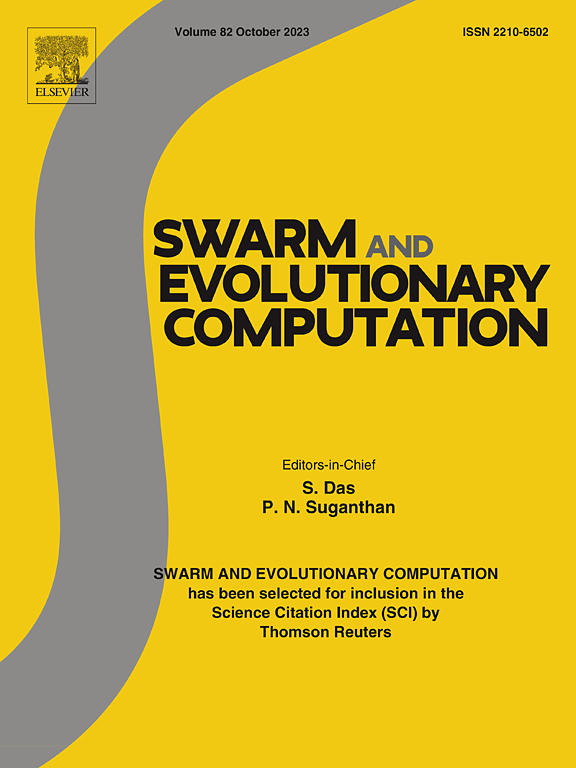GTG-ACO:用于启发式学习的图形转换器引导蚁群优化和用于组合优化的信息素动力学
IF 8.5
1区 计算机科学
Q1 COMPUTER SCIENCE, ARTIFICIAL INTELLIGENCE
引用次数: 0
摘要
组合优化(CO)问题是许多实际应用程序的基础,从物流和调度到资源分配。蚁群优化算法(Ant Colony Optimization, ACO)是一种广泛应用于求解CO问题的元启发式算法,它通过模拟合作觅食行为来迭代构建高质量的解。然而,传统的蚁群算法存在人工设计的启发式函数,无法在不同实例间进行泛化,且信息素初始化一致,导致算法的搜索效率低下,收敛速度慢。为了解决这些限制,我们引入了图转换器引导蚁群优化- GTG-ACO,这是一种联合学习启发式和初始信息素矩阵的新方法,使模型能够在不需要手动调整的情况下泛化不同的问题实例。此外,GTG-ACO采用图形转换器增强挤压激励(SE)网络作为启发式学习和信息素学习的主干。图转换器通过利用注意机制来动态捕获组合优化问题图表示中的结构关系,从而实现自适应表示学习。此外,SE网络通过重新校准特征的重要性来增强模型,确保关键信息被放大,同时抑制不太相关的特征。对四个组合优化问题——旅行商问题(TSP)、有能力车辆路线问题(CVRP)、单机总加权延迟问题(SMTWTP)和装箱问题(BPP)——的广泛评估表明,GTG-ACO始终优于最先进的基线,实现了1%至56%的改进。此外,我们通过在基准数据集TSPLIB和CVRPLIB上对其进行评估来验证其在现实世界中的适用性。因此,GTG-ACO通过联合学习启发式矩阵和信息素矩阵,使其成为一个强大且可推广的框架,从而实现更明智的探索,从而提高组合优化问题的解决质量。我们的代码可以在https://github.com/abrarrahmanabir/GTG-ACO上公开获得。本文章由计算机程序翻译,如有差异,请以英文原文为准。
GTG-ACO: Graph Transformer Guided Ant Colony Optimization for learning heuristics and pheromone dynamics for combinatorial optimization
Combinatorial optimization (CO) problems are fundamental to numerous real-world applications, ranging from logistics and scheduling to resource allocation. For solving CO problems, Ant Colony Optimization (ACO) is a widely used metaheuristic that simulates cooperative foraging behavior to iteratively construct high-quality solutions. However, traditional ACO suffers from handcrafted heuristic functions that fail to generalize across different instances and uniform pheromone initialization, which results in inefficient exploration and slow convergence.
To address these limitations, we introduce Graph Transformer Guided Ant Colony Optimization- GTG-ACO, a novel approach that jointly learns both heuristic and initial pheromone matrices, enabling the model to generalize across diverse problem instances without manual tuning. Additionally, GTG-ACO employs Graph Transformer augmented with Squeeze-and-Excitation (SE) network as the backbone for heuristic and pheromone learner. The Graph Transformers enable adaptive representation learning by leveraging attention mechanisms to dynamically capture structural relationships in graph representation of combinatorial optimization problems. Additionally, SE networks enhance the model by recalibrating feature importance, ensuring that critical information is amplified while suppressing less relevant features. Extensive evaluations on four combinatorial optimization problems—Traveling Salesman Problem (TSP), Capacitated Vehicle Routing Problem (CVRP), Single Machine Total Weighted Tardiness Problem (SMTWTP) and Bin Packing Problem (BPP)—demonstrate that GTG-ACO consistently outperforms state-of-the-art baselines achieving improvements ranging from 1% to 56%. Furthermore, we validate its real-world applicability by evaluating it on benchmark datasets TSPLIB and CVRPLIB. Thus, GTG-ACO establishes itself as a powerful and generalizable framework by jointly learning heuristic and pheromone matrices, enabling more informed exploration, which leads to superior solution quality in combinatorial optimization problems. Our code is publicly available at https://github.com/abrarrahmanabir/GTG-ACO.
求助全文
通过发布文献求助,成功后即可免费获取论文全文。
去求助
来源期刊

Swarm and Evolutionary Computation
COMPUTER SCIENCE, ARTIFICIAL INTELLIGENCEC-COMPUTER SCIENCE, THEORY & METHODS
CiteScore
16.00
自引率
12.00%
发文量
169
期刊介绍:
Swarm and Evolutionary Computation is a pioneering peer-reviewed journal focused on the latest research and advancements in nature-inspired intelligent computation using swarm and evolutionary algorithms. It covers theoretical, experimental, and practical aspects of these paradigms and their hybrids, promoting interdisciplinary research. The journal prioritizes the publication of high-quality, original articles that push the boundaries of evolutionary computation and swarm intelligence. Additionally, it welcomes survey papers on current topics and novel applications. Topics of interest include but are not limited to: Genetic Algorithms, and Genetic Programming, Evolution Strategies, and Evolutionary Programming, Differential Evolution, Artificial Immune Systems, Particle Swarms, Ant Colony, Bacterial Foraging, Artificial Bees, Fireflies Algorithm, Harmony Search, Artificial Life, Digital Organisms, Estimation of Distribution Algorithms, Stochastic Diffusion Search, Quantum Computing, Nano Computing, Membrane Computing, Human-centric Computing, Hybridization of Algorithms, Memetic Computing, Autonomic Computing, Self-organizing systems, Combinatorial, Discrete, Binary, Constrained, Multi-objective, Multi-modal, Dynamic, and Large-scale Optimization.
 求助内容:
求助内容: 应助结果提醒方式:
应助结果提醒方式:


